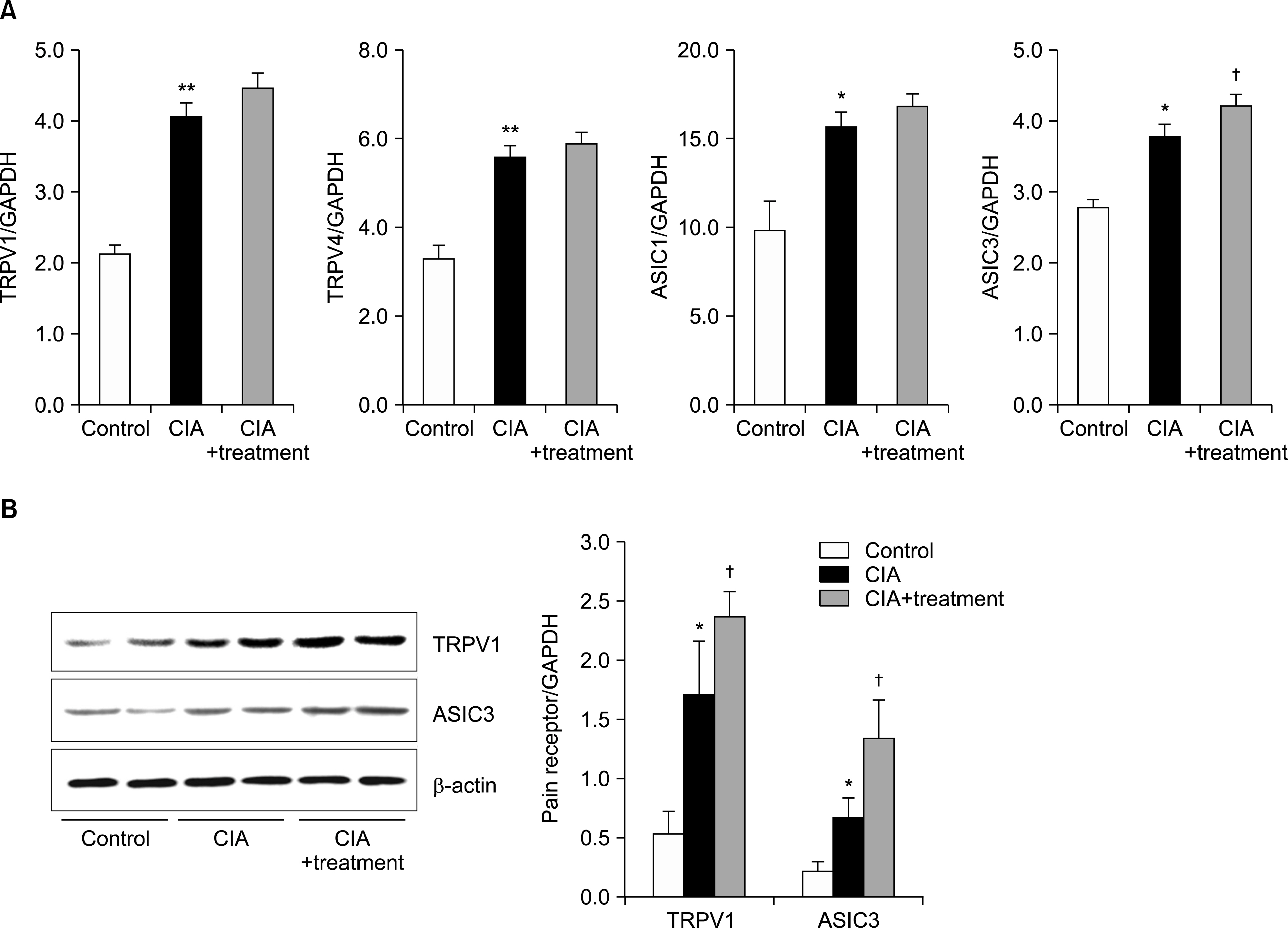J Rheum Dis.
2015 Apr;22(2):85-92. 10.4078/jrd.2015.22.2.85.
Expression of Pain Receptors by Arthritis Treatment in Collagen Induced Murine Model of Rheumatoid Arthritis
- Affiliations
-
- 1Department of Internal Medicine, Keimyung University School of Medicine, Daegu, Korea.
- 2Department of Biochemistry, Keimyung University School of Medicine, Daegu, Korea.
- 3Pain Research Center, Keimyung University School of Medicine, Daegu, Korea.
- 4Department of Internal Medicine, Yeungnam University College of Medicine, Daegu, Korea. sarang7529@hanmail.net
- KMID: 2222910
- DOI: http://doi.org/10.4078/jrd.2015.22.2.85
Abstract
OBJECTIVE
Rheumatoid arthritis, the most common form of arthritis, is typically characterized by induced inflammatory pain in joints. Recent studies have reported on the expression of pain receptors such as transient receptor potential vanilloid 1 (TRPV1) and acid sensing ion channel 3 (ASIC3), which are related to pain induction and regulation. This study was conducted to investigate the expression of TRPV1 and ASIC3 in response to the analgesic effect of an arthritis treatment in a collagen-induced arthritis (CIA).
METHODS
Mice were divided into 3 groups: Control, CIA, and CIA with arthritis treatment. Mice received intraperitoneal injection with 10 mg/kg infliximab and 10 mg/kg meloxicam five times per week for 3 weeks. Mechanical hyperalgesia, histologic examination of the feet, serum levels of inflammatory cytokine such as interleukin-6 (IL-6), and interleukin-17 (IL-17), TRPV1 and ASIC3 expression were investigated.
RESULTS
The serum levels of IL-6 and IL-17 were lower in the treatment group (73.77+/-10.11 pg/mL and 26.75+/-7.17 pg/mL, respectively) compared to the CIA group (p<0.001). Histological analysis showed decreased synovial cell proliferation, leukocyte infiltration, and cartilage destruction in the treatment group compared with the CIA group. The CIA group that underwent arthritis treatment showed a significantly increased withdrawal threshold of mechanical nociception on the hind paw and increased expression of TRPV1 and ASIC3 compared to the CIA group.
CONCLUSION
Arthritis treatment resulted in an anti-inflammatory and analgesic effect through upregulation of the activity of TRPV1 and ASIC3 in CIA mice.
Keyword
MeSH Terms
Figure
Reference
-
1. Choy EH, Panayi GS. Cytokine pathways and joint inflammation in rheumatoid arthritis. N Engl J Med. 2001; 344:907–16.
Article2. Watkins LR, Maier SF, Goehler LE. Immune activation: the role of proinflammatory cytokines in inflammation, illness responses and pathological pain states. Pain. 1995; 63:289–302.
Article3. Kojima M, Kojima T, Ishiguro N, Oguchi T, Oba M, Tsuchiya H, et al. Psychosocial factors, disease status, and quality of life in patients with rheumatoid arthritis. J Psychosom Res. 2009; 67:425–31.
Article4. Billeter AT, Hellmann JL, Bhatnagar A, Polk HC Jr. Transient receptor potential ion channels: powerful regulators of cell function. Ann Surg. 2014; 259:229–35.5. Mamet J, Baron A, Lazdunski M, Voilley N. Proinflammatory mediators, stimulators of sensory neuron excitability via the expression of acid-sensing ion channels. J Neurosci. 2002; 22:10662–70.
Article6. Steen KH, Reeh PW. Sustained graded pain and hyperalgesia from harmless experimental tissue acidosis in human skin. Neurosci Lett. 1993; 154:113–6.
Article7. Waldmann R, Lazdunski M. H(+)-gated cation channels: neuronal acid sensors in the NaC/DEG family of ion channels. Curr Opin Neurobiol. 1998; 8:418–24.
Article8. Han Z, Boyle DL, Manning AM, Firestein GS. AP-1 and NF-kappaB regulation in rheumatoid arthritis and murine collagen-induced arthritis. Autoimmunity. 1998; 28:197–208.9. Chaplan SR, Pogrel JW, Yaksh TL. Role of voltage-depend-ent calcium channel subtypes in experimental tactile allodynia. J Pharmacol Exp Ther. 1994; 269:1117–23.10. Stuart JM, Townes AS, Kang AH. Collagen autoimmune arthritis. Annu Rev Immunol. 1984; 2:199–218.
Article11. Kim HO, Lee SI. Experimental animal models for rheumatoid arthritis: methods and applications. J Rheum Dis. 2012; 19:189–95.
Article12. Sokka T. Assessment of pain in patients with rheumatic diseases. Best Pract Res Clin Rheumatol. 2003; 17:427–49.
Article13. Melzack R. The McGill Pain Questionnaire: major properties and scoring methods. Pain. 1975; 1:277–99.
Article14. Deval E, Noël J, Lay N, Alloui A, Diochot S, Friend V, et al. ASIC3, a sensor of acidic and primary inflammatory pain. EMBO J. 2008; 27:3047–55.
Article15. Chung MK, Jung SJ, Oh SB. Role of TRP channels in pain sensation. Adv Exp Med Biol. 2011; 704:615–36.
Article16. Zhang X, Huang J, McNaughton PA. NGF rapidly increases membrane expression of TRPV1 heat-gated ion channels. EMBO J. 2005; 24:4211–23.
Article17. Ikeuchi M, Kolker SJ, Burnes LA, Walder RY, Sluka KA. Role of ASIC3 in the primary and secondary hyperalgesia produced by joint inflammation in mice. Pain. 2008; 137:662–9.
Article18. Suzuki M, Mizuno A, Kodaira K, Imai M. Impaired pressure sensation in mice lacking TRPV4. J Biol Chem. 2003; 278:22664–8.
Article19. Staikopoulos V, Sessle BJ, Furness JB, Jennings EA. Localization of P2X2 and P2X3 receptors in rat trigeminal ganglion neurons. Neuroscience. 2007; 144:208–16.
Article20. Plant TD, Zöllner C, Kepura F, Mousa SS, Eichhorst J, Schaefer M, et al. Endothelin potentiates TRPV1 via ETA receptor-mediated activation of protein kinase C. Mol Pain. 2007; 3:35.
Article21. Sluka KA, Rasmussen LA, Edgar MM, O'Donnell JM, Walder RY, Kolker SJ, et al. Acid-sensing ion channel 3 deficiency increases inflammation but decreases pain behavior in murine arthritis. Arthritis Rheum. 2013; 65:1194–202.
Article22. Anand P, Bley K. Topical capsaicin for pain management: therapeutic potential and mechanisms of action of the new high-concentration capsaicin 8% patch. Br J Anaesth. 2011; 107:490–502.
Article23. Baek SJ, Wilson LC, Lee CH, Eling TE. Dual function of nonsteroidal anti-inflammatory drugs (NSAIDs): inhibition of cyclooxygenase and induction of NSAID-activated gene. J Pharmacol Exp Ther. 2002; 301:1126–31.
Article24. Mimeault M, Batra SK. Divergent molecular mechanisms underlying the pleiotropic functions of macrophage inhibitory cytokine-1 in cancer. J Cell Physiol. 2010; 224:626–35.
Article
- Full Text Links
- Actions
-
Cited
- CITED
-
- Close
- Share
- Similar articles
-
- Lessons for the pathogenesis of rheumatoid arthritis acquired from experimental animal models
- The Expression of Toll-like Receptors in Collagen-induced Arthritis
- Cytokines in rheumatoid arthritis
- A Case of Winkelmann Granuloma Associated with Hypothyroidism and Rheumatoid Arthritis
- Two Cases of Psoriatic Arthritis






